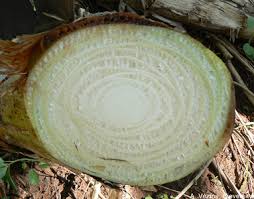The pseudostem is the part of the banana plant that looks like a trunk. It is formed by the tightly packed overlapping leaf sheaths. Even though the pseudostem is very fleshy and consists mostly of water, it is quite sturdy and can support a bunch that weighs 50 kg or more.

Plant stem
A stem is one of two main structural axes of a vascular plant, the other being the root. The stem is normally divided into nodes and internodes:
- The nodes hold one or more leaves, as well as buds which can grow into branches (with leaves, conifer cones, or inflorescences (flowers)). Adventitious roots may also be produced from the nodes.
- The internodes distance one node from another.
The term "shoots" is often confused with "stems"; "shoots" generally refers to new fresh plant growth including both stems and other structures like leaves or flowers. In most plants stems are located above the soil surface but some plants have underground stems.
Stems have four main functions which are:[1]
- Support for and the elevation of leaves, flowers and fruits. The stems keep the leaves in the light and provide a place for the plant to keep its flowers and fruits.
- Transport of fluids between the roots and the shoots in the xylem and phloem
- Storage of nutrients
- Production of new living tissue. The normal lifespan of plant cells is one to three years. Stems have cells called meristems that annually generate new living tissue.
Contents
Specialized terms[edit]
Stems are often specialized for storage, asexual reproduction, protection or photosynthesis, including the following:
- Acaulescent – used to describe stems in plants that appear to be stemless. Actually these stems are just extremely short, the leaves appearing to rise directly out of the ground, e.g. some Viola species.
- Arborescent – tree like with woody stems normally with a single trunk.
- Axillary bud – a bud which grows at the point of attachment of an older leaf with the stem. It potentially gives rise to a shoot.
- Branched – aerial stems are described as being branched or unbranched
- Bud – an embryonic shoot with immature stem tip.
- Bulb – a short vertical underground stem with fleshy storage leaves attached, e.g. onion, daffodil, tulip. Bulbs often function in reproduction by splitting to form new bulbs or producing small new bulbs termed bulblets. Bulbs are a combination of stem and leaves so may better be considered as leaves because the leaves make up the greater part.
- Caespitose – when stems grow in a tangled mass or clump or in low growing mats.
- Cladode (including phylloclade) – a flattened stem that appears more-or-less leaf like and is specialized for photosynthesis,[2] e.g. cactus pads.
- Climbing – stems that cling or wrap around other plants or structures.
- Corm – a short enlarged underground, storage stem, e.g. taro, crocus, gladiolus.
- Decumbent – stems that lie flat on the ground and turn upwards at the ends.
- Fruticose – stems that grow shrublike with woody like habit.
- Herbaceous – non woody, they die at the end of the growing season.
- Internode – an interval between two successive nodes. It possesses the ability to elongate, either from its base or from its extremity depending on the species.
- Node – a point of attachment of a leaf or a twig on the stem in seed plants. A node is a very small growth zone.
- Pedicel – stems that serve as the stalk of an individual flower in an inflorescence or infrutescence.
- Peduncle – a stem that supports an inflorescence
- Prickle – a sharpened extension of the stem's outer layers, e.g. roses.
- Pseudostem – a false stem made of the rolled bases of leaves, which may be 2 or 3 m tall as in banana
- Rhizome – a horizontal underground stem that functions mainly in reproduction but also in storage, e.g. most ferns, iris
- Runner (plant part) – a type of stolon, horizontally growing on top of the ground and rooting at the nodes, aids in reproduction. e.g. garden strawberry, Chlorophytum comosum.
- Scape – a stem that holds flowers that comes out of the ground and has no normal leaves. Hosta, Lily, Iris, Garlic.
- Stolon – a horizontal stem that produces rooted plantlets at its nodes and ends, forming near the surface of the ground.
- Thorn – a modified stem with a sharpened point.
- Tuber – a swollen, underground storage stem adapted for storage and reproduction, e.g. potato.
- Woody – hard textured stems with secondary xylem.



No comments:
Post a Comment